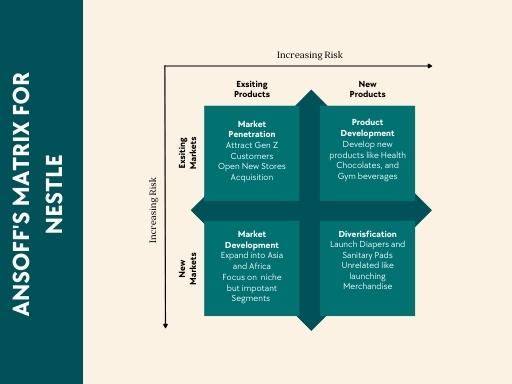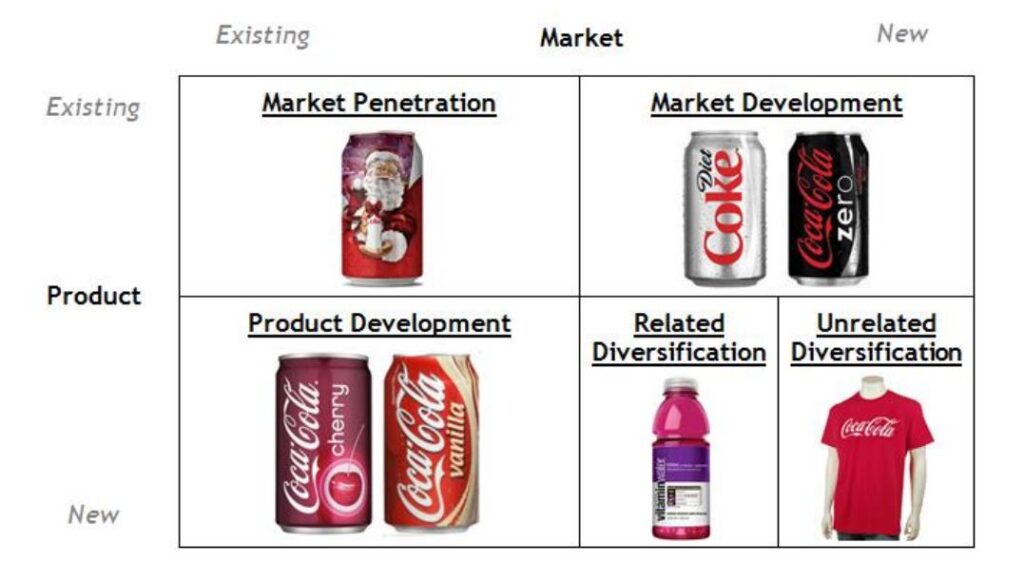What is the Ansoff Matrix?
Ansoff matrix also known as corporate Ansoff matrix and product/market expansion grid is an essential business strategy tool used in business schools globally. The model focuses on providing a structure for business owners and marketers to strategize growth and risks of growth for their businesses. The Ansoff Matrix can be used during various stages of a product or a company life cycle making it one of the most versatile tools for managers. From Strategic Exercise to Market Planning,
Ansoff matrix helps marketers get opportunities to grow their sales and generate revenue by using different combinations of new markets and products and existing markets and products.
Ansoff Matrix finds wide usage in almost every field of management. Ansoff Matrix also helps in identifying potential growth areas and areas where management should retract, making it an important tool for business prioritization as well. The universality of the tool makes it a favorite of strategic consultants who carve out new and niche strategies for the organization. in this blog, we will discuss in detail the history, usage, and advantages of a case study.
Find other Tools for Management assessments here

History of Ansoff matrix
H. Igor Ansoff, an applied mathematician, and business manager developed the Ansoff model. The matrix was first published in Harvard Business Review in 1957 under an article called “strategies for diversification”. In his model, Ansoff has hinted at some of the strongest and weakest business strategies.
According to Ansoff, there are only two approaches to developing a growth strategy, diversifying Product Growth and Market Growth.
Uses of Ansoff matrix
Ansoff matrix can be used to assess the different strategies for business growth also known as the four quadrants of the Ansoff model. The four quadrants are:
- Market penetration
- Product development
- Market development
- Diversification
Market penetration
In the first quadrant, market penetration is the safest with minimum risk. This strategy focuses on increasing sales of existing products or offerings in the markets you are already familiar with. This can be achieved by:
- Lowering your prices or giving discounts
- Promoting your business on a larger scale
- Buying or obtaining a rival’s company in the very market
- Changing opening hours for stores
- Focusing on product refinement
For a better understanding, let us take an example: Popular brands like coca cola are known to focus a lot on getting their brand distributed among the right target audience. They spend a lot of money on getting help from supermarkets, sports stadiums, diners, etc. to penetrate the market and get their brand sold on a higher scale.
Product development
In the second quadrant, product development is riskier than market penetration. This strategy focuses on selling new products in the existing markets. You can also modify the products or extend the range of existing products. The strategy also focuses on the needs and welfare of target customers and markets. This can be achieved by:
- Making investments in the research and development of new products.
- Buying someone else’s products and obtaining the rights to claim them as one’s own.
- Acquiring the rights to build someone else’s products
- Creating new packaging for the existing products
The strategy also focuses on the needs and welfare of target customers and markets. A good example of product development can be taken from the pharmaceutical companies that have been actively investing in the research and development of new drugs.
Market development
Market development or the third quadrant carries furthermore risks. The strategy focuses on sales of existing offerings in new markets and among different types of customers. This can be accomplished by:
- Promoting your offerings in different customer segments
- Targeting markets in new areas of the country
- Foreign marketing
- Taking the help of online sales
Market development strategy is not that risky if the new markets are similar to the previous ones that you are familiar with. This can be better understood with an example, such as: google started in California, United States but extended its business to Chinese markets.
Diversification
In the last quadrant, diversification is the riskiest of all. It focuses on taking new products into new markets. Even with high risks, diversification can sometimes procure greater rewards. This strategy can be of two types, related and unrelated.
- Related diversification: there remains a connection between the new offerings and the existing firms/businesses.
- Unrelated diversification: there are no connections between the businesses and the new offerings.
The strategy proves to give an edge in a way that, if one business fails to flourish, the others will remain unaffected. Let us take two examples to understand each of these diversifications better.
A shoemaker making shoe with leather decides to make belts and bags instead. This is a case of related diversification as the products are different but the raw material is common for both. Another example can be the company Samsung. Samsung offers a variety of products from mobile phones, laptops, and air conditioners to hotel chains, insurance, and chemicals. This example is of unrelated diversification. Even if the hotel chains don’t return promising results, mobile phone sales of Samsung won’t be affected.
Advantages/Benefits of using Ansoff Matrix
Simplicity: Ansoff Matrix is a very simple yet powerful tool for visualization for managers. Many managers depend on Ansoff Matrix to find the right strategy for the organization
Easier for brainstorming: Unlike other strategic tools, Ansoff Matrix is perfect for a brainstorming session.
Management Summary: The final outcome of a strategic exercise is often very complex. With Ansoff Matrix, it is relatively easier to find a management summary easily. It also becomes easier for an organization to communicate new or changed strategies down the line.
Universality: The Ansoff matrix is very universal. It can be used in a wide range of problems ranging from consulting to new business expansion to strategic marketing problems. It is widely used in assessing the current strategy and finding what’s needed to go to derived strategy
Ansoff Matrix: Case Studies
NESTLE

Founded by Henri Nestle, the famous multinational company, Nestle is one of the world’s largest food and drinks processing companies. Nestle was started in 1866 as a small firm known to produce infant milk and now it has earned the name of a business with the most winning marketing strategy. It is headquartered in Switzerland. The products the company offers are diverse, such as beverages, ice creams, baby food, pet food, bottled water, etc.
For over 150 years, their business has been flourishing. The company also possesses a special focus on sustainable development. They have the largest research and development network in the food and beverage industry which makes them stand out. With the tagline “Good Food, Good Life”, the brand has created a catalyst to promote its sales.
Nestle is a multibillion-dollar company with a market capitalization of more than 247 billion USD. As of 2021, the brand has generated a revenue of around CHF 87.10 billion. Nestle has made use of Ansoff Matrix successfully over the years to become the leading international food processing brand in the world. Let us have a look at the strategic analysis of the Ansoff Matrix of Nestle.
Market penetration by Nestle
For smooth market penetration, Nestle uses its existing products in the existing markets to grow their sales. They focus on aggressive marketing to increase purchases. Nestle uses various tactics to grow their sales such as manufacturing different packaging sizes to give customers a wider choice of selection, offering discounts on larger purchases, lowering prices on certain products, etc.
They are also known to acquire similar brands and companies to reduce competition. Nestle uses promotion strategies like encouraging people to purchase their products by including the customers’ pain points in their advertisements. The brand also keeps on introducing new flavors to keep their customers interested in their products.
Product development by Nestle
Nestle launches new products in the existing markets almost regularly. For instance, they first manufactured chocolates that many customers liked. They later went one step ahead and introduced ice creams using those chocolate flavors.
To promote these ice creams they kept the prices low, advertised more, and used different channels to increase the reach of their products. Once the ice creams were a hit, they adjusted the prices, improved the packaging, and also introduced more variants of the product. All this helped them generate revenue from the ice creams and grew their sales. This is how Nestle focuses on its product development
Market development by Nestle
Nestle uses exciting products in new markets for market development. They expand consistently to new geographical areas where they haven’t marketed yet. They make sure that the products are readily available with the help of different distribution channels to help them increase their reach to the local markets. For this very goal, they also advertise the products through the regional media. They also focus on making the products affordable, targeting the customers’ needs, and introducing variants according to the preference of customers from that particular region. For example, India has more variants of Maggi instant noodles that aren’t available elsewhere.
Diversification by nestle
Nestle regularly launches new products in new markets for diversification. The new products can be related to the existing range of products or can be a different range itself. For example, Nestle offers baby food but they can also launch diapers and other baby products in new markets to grow their sales. Of course, it takes a strategic plan to execute such a stunt with so much risk. But with such marketing understanding, Nestle rarely disappoints.
COCA-COLA
Coca-Cola is a giant in the beverage industry. It serves almost every continent in the world.

Samrat is a Delhi-based MBA from the Indian Institute of Management. He is a Strategy, AI, and Marketing Enthusiast and passionately writes about core and emerging topics in Management studies. Reach out to his LinkedIn for a discussion or follow his Quora Page
